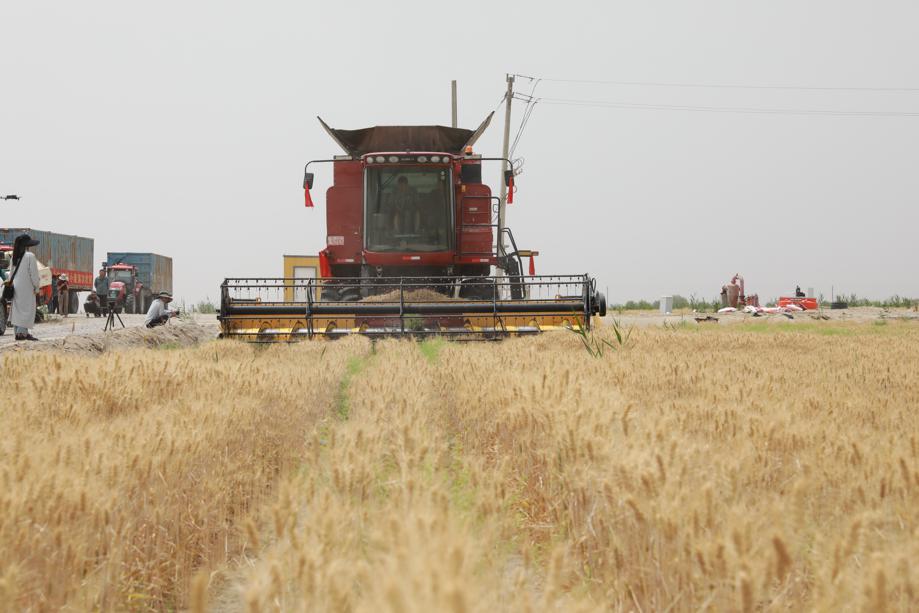China’s largest pure-desert wheat field combats desertification
chinadaily.com.cn2024-06-18 23:42

The wheat planting team took a group photo before starting the harvest in Makit county, Kashgar prefecture, Xinjiang Uygur autonomous region. [Photo by Yang Jun/for chinadaily.com.cn]
In the vast Taklamakan Desert, also known as the "sea of death" in China, a remarkable feat is taking place.
A large wheat field has been successfully trial-planted on the southwestern edge of the desert in Makit county, Kashgar prefecture, Xinjiang Uygur autonomous region.
The wheat plantation now covers over 400 hectares, making it China's largest pure-desert wheat field and marking a new approach to combating desertification through sustainable agriculture.

A harvester is working in the desert wheat field, with the Taklamakan Desert visible in the distance. [Photo by Yang Jun/for chinadaily.com.cn]
"The harvested wheat has reached the top grade, with an average yield of 294 kilograms per mu, surpassing our expectations," announced Wang Jianjun, deputy general manager of Xinjiang Wuzheng Green Agricultural Development Co, at the harvest site in early June.
Makit county is surrounded by sand on three sides and desert accounts for 90 percent of its total area.
Over 36,000 hectares of the county's land are mildly saline-alkali, and those levels are severe in another 13,333 hectares, making sand control and disaster mitigation urgent.

A harvester is working in the desert wheat field, with the Taklamakan Desert visible in the distance. [Photo by Yang Jun/for chinadaily.com.cn]
To explore models for improving desert saline-alkali land, the command center of Shandong province which provides pairing assistance for Xinjiang has invested 30 million yuan ($4.1 million), supporting Xinjiang Wuzheng in managing 1,333 hectares of desert land to plant wheat.
"Sand control and reclamation are significant for ensuring food security, improving the ecological environment, increasing regional economic income, and promoting sustainable agricultural development and technological innovation," said Gu Quanjun, head of the company's wheat base program.
It's not easy to plant wheat in the desert. The Taklamakan Desert is constantly shifting, so the land needs to be quickly planted with vegetation after leveling; otherwise, a sandstorm could revert it to its original state.

A view of the wheat field. [Photo by Yang Jun/for chinadaily.com.cn]
Traditional wheat planting methods face many challenges in the desert due to low soil organic matter and nutrient content, high evaporation rates, poor water and fertilizer retention, and high salinity.
To ensure successful planting, Gu said, "We use a precise, quantitative, and high-frequency irrigation method to deliver the necessary nutrients and water to the wheat roots."
"The key factor for successful trial planting is our innovative development of a systematic management application technology tailored to the desert's unique climate and soil conditions, addressing various issues at every planting stage," he said.

A harvester is working in the desert wheat field, with the Taklamakan Desert visible in the distance. [Photo by Yang Jun/for chinadaily.com.cn]
The project also collaborates with research institutes such as the Chinese Academy of Agricultural Sciences and the Shandong Academy of Agricultural Sciences, using technologies like satellite positioning and remote sensing monitoring.
According to Xinjiang Wuzhengh, this has enabled precise crop planting, fertilization and pest control management, creating a replicable and scalable standardized technique for desert wheat cultivation that fosters new productive capacities.
Yang Jun, an official from the pairing assistance command in Shandong's Rizhao, said the next step is to expand the winter wheat planting area.
"In the next three to five years, our goal is to plant wheat on over 3,333 hectares of desert land. This will enhance the quality and efficiency of the region's agriculture while promoting comprehensive rural revitalization," Yang said.

A harvester is working in the desert wheat field, with the Taklamakan Desert visible in the distance. [Photo by Yang Jun/for chinadaily.com.cn]
Xinjiang has recently beefed up its efforts to foster new productive capacities on desert land.
In late April, a research team from the Chinese Academy of Agricultural Sciences successfully trial-planted and rapidly cultivated rice in a desert greenhouse in Hotan prefecture, Xinjiang.
The Hotan region in southern Xinjiang has abundant light and heat resources.
This breakthrough in rapid crop cultivation technology in desert greenhouses will also provide technical support for year-round crop generation and rapid breeding in the southern deserts of Xinjiang, according to the institution.
